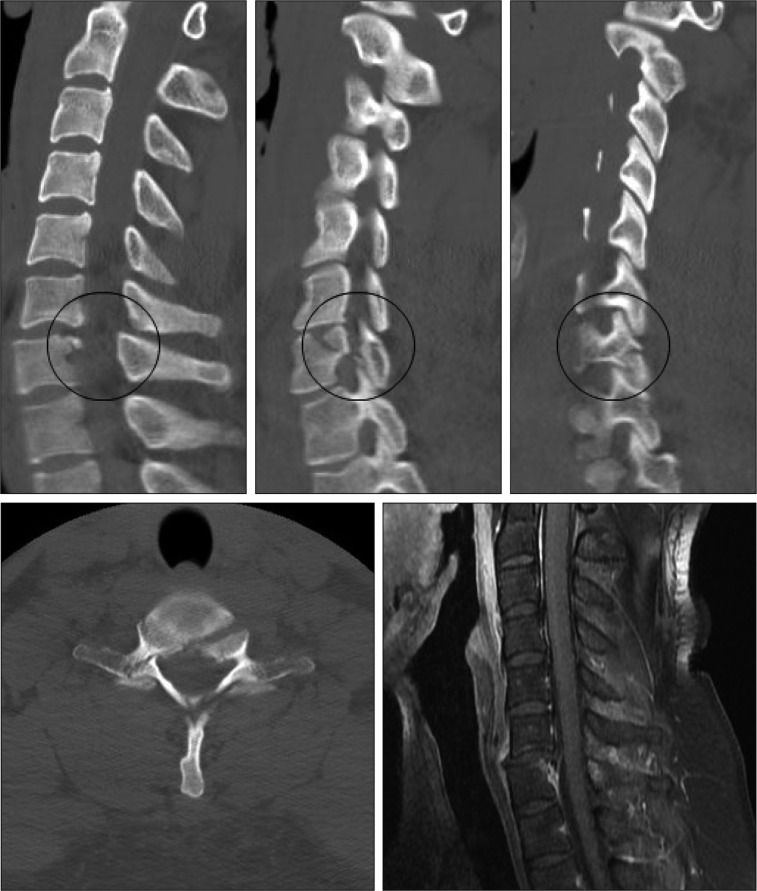J Korean Neurosurg Soc.
2012 Sep;52(3):200-203.
Interobserver and Intraobserver Reliability of Sub-Axial Injury Classification and Severity Scale between Radiologist, Resident and Spine Surgeon
- Affiliations
-
- 1Department of Neurosurgery, Inha University College of Medicine, Incheon, Korea. nsyoon@gmail.com
- 2Department of Radiology, Inha University College of Medicine, Incheon, Korea.
- 3Department of Neurosurgery, Korea Armed Forces Busan Hospital, Busan, Korea.
Abstract
OBJECTIVE
The sub-axial injury classification (SLIC) and severity scale was developed to decide whether to operate the cervical injured patient or not, but the reliability of SLIC and severity scale among the different physicians was not well known. Therefore, we evaluated the reliability of SLIC among a spine surgeon, a resident of neurosurgery and a neuro-radiologist.
METHODS
In retrograde review in single hospital from 2002 to 2009 years, 75 cases of sub-axial spine injured patients underwent operation. Each case was blindly reviewed for the SLIC and severity scale by 3 different observers by two times with 4 weeks interval with randomly allocated. The compared axis was the injury morphology score, the disco-ligamentous complex score, the neurological status score and total SLIC score; the neurological status score was derived from the review of medical record. The kappa value was used for the statistical analysis.
RESULTS
Interobserver agreement of SLIC and severity scale was substantial agreement in the score of injury morphology [intraclass correlation (ICC)=0.603] and total SLIC and severity sacle (ICC value=0.775), but was fair agreement in the disco-ligamentous complex score (ICC value=0.304). Intraobserver agreements were almost perfect agreement in whole scales with ICC of 0.974 in a spine surgeon, 0.948 in a resident of neurosurgery, and 0.963 in a neuro-radiologist.
CONCLUSION
The SLIC and severity scale is comprehensive and easily applicable tool in spine injured patient. Moreover, it is very useful tool to communicate among spine surgeons, residents of neurosurgery and neuro-radiologists with sufficient reproducibility.
Keyword
Figure
Reference
-
1. Allen BL Jr, Ferguson RL, Lehmann TR, OBrien RP. A mechanistic classification of closed, indirect fractures and dislocations of the lower cervical spine. Spine (Phila Pa 1976). 1982; 7:1–27. PMID: 7071658.
Article2. Anderson PA, Moore TA, Davis KW, Molinari RW, Resnick DK, Vaccaro AR, et al. Cervical spine injury severity score. Assessment of reliability. J Bone Joint Surg Am. 2007; 89:1057–1065. PMID: 17473144.3. Bono CM, Schoenfeld A, Gupta G, Harrop JS, Anderson P, Patel AA, et al. Reliability and reproducibility of subaxial cervical injury description system : a standardized nomenclature schema. Spine (Phila Pa 1976). 2011; 36:E1140–E1144. PMID: 21587109.4. Dvorak MF, Fisher CG, Fehlings MG, Rampersaud YR, Oner FC, Aarabi B, et al. The surgical approach to subaxial cervical spine injuries : an evidence-based algorithm based on the SLIC classification system. Spine (Phila Pa 1976). 2007; 32:2620–2629. PMID: 17978665.5. Harris JH Jr, Edeiken-Monroe B, Kopaniky DR. A practical classification of acute cervical spine injuries. Orthop Clin North Am. 1986; 17:15–30. PMID: 3511428.
Article6. Holdsworth F. Fractures, dislocations, and fracture-dislocations of the spine. J Bone Joint Surg Am. 1970; 52:1534–1551. PMID: 5483077.
Article7. Hwang IC, Kang DH, Han JW, Park IS, Lee CH, Park SY. Clinical experiences and usefulness of cervical posterior stabilization with polyaxial screw-rod system. J Korean Neurosurg Soc. 2007; 42:311–316. PMID: 19096562.
Article8. Oner FC, van Gils AP, Dhert WJ, Verbout AJ. MRI findings of thoracolumbar spine fractures : a categorisation based on MRI examinations of 100 fractures. Skeletal Radiol. 1999; 28:433–443. PMID: 10486011.
Article9. Sanders RW. The problem with apples and oranges. J Orthop Trauma. 1997; 11:465–466.
Article10. Vaccaro AR, Hulbert RJ, Patel AA, Fisher C, Dvorak M, Lehman RA Jr, et al. The subaxial cervical spine injury classification system : a novel approach to recognize the importance of morphology, neurology, and integrity of the disco-ligamentous complex. Spine (Phila Pa 1976). 2007; 32:2365–2374. PMID: 17906580.11. Vaccaro AR, Lehman RA Jr, Hurlbert RJ, Anderson PA, Harris M, Hedlund R, et al. A new classification of thoracolumbar injuries : the importance of injury morphology, the integrity of the posterior ligamentous complex, and neurologic status. Spine (Phila Pa 1976). 2005; 30:2325–2333. PMID: 16227897.12. Viera AJ, Garrett JM. Understanding interobserver agreement : the kappa statistic. Fam Med. 2005; 37:360–363. PMID: 15883903.13. Watson-Jones R. The results of postural reduction of fractures of the spine. J Bone Joint Surg Am. 1938; 20:567–586.
- Full Text Links
- Actions
-
Cited
- CITED
-
- Close
- Share
- Similar articles
-
- The Reliability of Proximal Femoral Shaft Fracture Classification
- Comparison of TLICS & McAfee Classification in Thoracolumbar Injuries
- A new classification of atlas fracture based on computed tomography: reliability, reproducibility, and preliminary clinical significance
- An analysis of adolescent idiopathic scoliosis according to Coonrad classification
- Change of Reliability for Distal Metatarsal Articular Angle Measurement before and after Proximal Chevron Osteotomy


